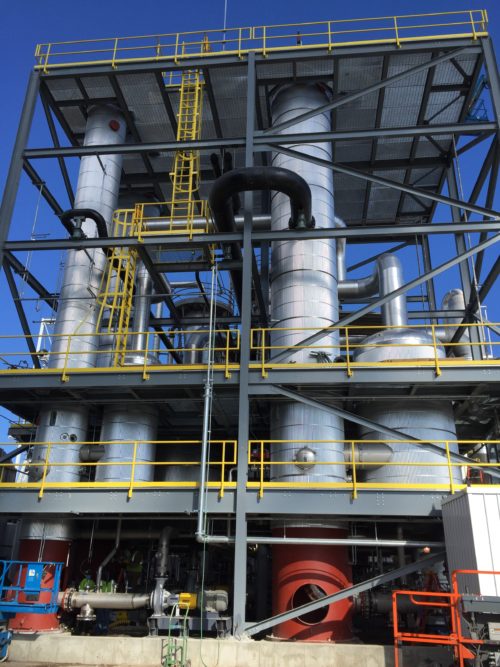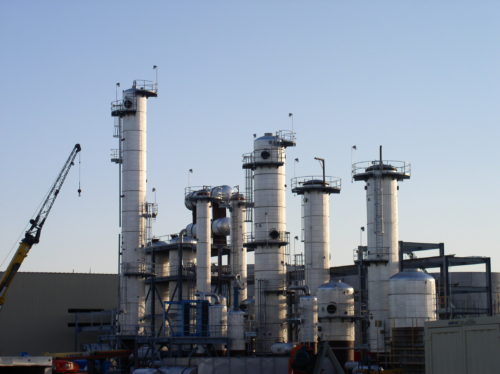What Is Thin Stillage?
Thin stillage evaporation concentrates a process stream consisting of water and dissolved solids. The process is most common in the ethanol industry, with the dissolved solids coming from the corn used to make ethanol. Undissolved solids typically have already been removed using a centrifuge. A stream that consists of both dissolved and undissolved solids is commonly known as whole stillage, a stream with just dissolved solids is thin stillage, while the concentrated thin stillage is referred to as syrup.
 A typical feed concentration to the evaporation system would be at 5% to 7%, while a typical final concentration from the evaporation system (the syrup) would have a concentration of 30% to 35%.
A typical feed concentration to the evaporation system would be at 5% to 7%, while a typical final concentration from the evaporation system (the syrup) would have a concentration of 30% to 35%.
Where Is It Found?
The most common application for thin stillage evaporation is in ethanol plants, utilizing corn as a feedstock and producing fuel grade ethanol. The thin stillage evaporators allow the ethanol plant to concentrate up the dissolved solids, to either go to a dryer or sold as syrup. The dissolved solids come upstream from the fermentation process and consist of solids not digested in the ethanol fermenters. The dried solids (DDGS, Dried Distillers Grains with Solubles) can be sold to cattle farmers as feed, and has a long shelf life. Alternately, the syrup (CCDS, Corn Condensed Distillers Solubles) can be fed to cattle, however it has a much shorter life span.
How Is the Thin Stillage Concentrated?
The thin stillage is concentrated by evaporating off the water, leaving a more concentrated stream. The process often requires multiple stages of evaporation and multiple effects to reduce the amount of heating media (steam) required.
Each time the process fluid is concentrated through evaporation, it’s considered one stage of evaporation. In a three stage evaporation system, for example, the thin stillage could be concentrated from 7% to 14%, then 14% to 30%, then finally 30% to 35%.
A multiple-effect evaporation system is a means by which we reduce utility steam consumption by utilizing the steam we generate in evaporation to evaporate the process stream in the next effect. We do this by reducing the pressure at which the evaporation takes place. As an example, the first stage evaporation may take place at 5.15 psia generating steam at 163.4F. The second effect would operate at 3.83 psia, where boiling would take place at 151.3F. The steam generated at 163.4F (produced using low-pressure steam available at the plant) would be utilized to generate the steam at 151.3 in the second effect. We could have a third effect as well, at a lower operating pressure and temperature.
Equipment Utilized
 Evaporation equipment utilized for this service typically consists of shell and tube heat exchangers, most often configured as falling film evaporators. Large diameter tubes are preferred as the thin stillage is fouling. As an alternate, plate and frame exchangers can also be utilized as suppressed boiling exchangers. Suppressed boiling occurs when the process steam has sufficient heat input into it in the liquid phase, as sensible heat under pressure, such that after exiting the exchanger it can be flashed. Suppressed boiling is utilized for plate and frame exchangers to reduce the potential for fouling of the plate and frame exchanger.
Evaporation equipment utilized for this service typically consists of shell and tube heat exchangers, most often configured as falling film evaporators. Large diameter tubes are preferred as the thin stillage is fouling. As an alternate, plate and frame exchangers can also be utilized as suppressed boiling exchangers. Suppressed boiling occurs when the process steam has sufficient heat input into it in the liquid phase, as sensible heat under pressure, such that after exiting the exchanger it can be flashed. Suppressed boiling is utilized for plate and frame exchangers to reduce the potential for fouling of the plate and frame exchanger.
The Thermal Kinetics Advantage
Thermal Kinetics has extensive experience designing complete thin stillage evaporation systems. Our goal is to provide a system with the best payback period, balancing the cost of the utility steam versus the cost for a multiple-effect evaporation system. Thermal Kinetics also provides systems utilizing mechanical vapor recompression to further reduce utility steam consumption.
Our systems are typically run under vacuum where the operating temperature is low, reducing fouling rates and thereby increasing run times. Thermal Kinetics can supply the control valves, pumps, and all ancillary equipment (skidded system). Further, we recommend to our customers that they utilize a CIP system (clean in place) designed by Thermal Kinetics to clean the equipment with very minimal downtime.


